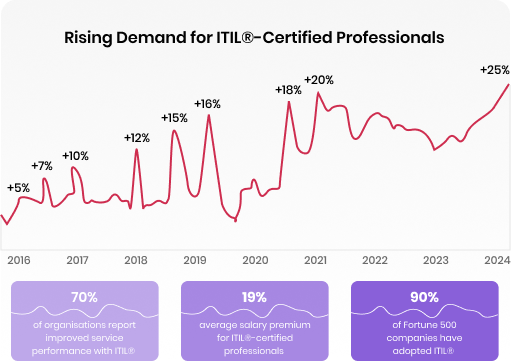ITIL® Practitioner Level
ITIL® Practitioner Level Courses build on foundational knowledge, focusing on applying ITIL® concepts in real-world scenarios. They equip professionals with practical tools for continual service improvement, stakeholder communication, and change adoption. It’s the essential next step for enhancing IT service delivery skills.
Browse Courses
ITIL® Practitioner
Duration: 2 Days

- Buxton
- Corby
- Derby
- Hinckley
- Leicester
- Lincoln
- Northampton
- Nottingham
- Birmingham
- Burton Upon Trent
- Coventry
- Solihull
- Stoke-on-Trent
- Warwick
- Wolverhampton
- Worcester
- Darlington
- Middlesbrough
- Newcastle
- Sunderland
- Carlisle
- Doncaster
- Harrogate
- Kingston upon Hull
- Leeds
- Sheffield
- Wakefield
- York
- Teesside
- Bath
- Bristol
- Cirencester
- Exeter
- Gloucester
- Plymouth
- Swindon
- Bournemouth
- Poole
- Brighton
- Canterbury
- Chatham
- Chichester
- Maidstone
- Portsmouth
- Southampton
- Tonbridge
- Jersey
- Bedford
- Luton
- Watford
- Bromley
- London
- Bracknell
- Milton Keynes
- Fleet
- Guildford
- High Wycombe
- Oxford
- Reading
- Slough
- Windsor Town
- Wokingham
- Gatwick
- Virtuals
- Heathrow
- Cambridge
- Chelmsford
- Colchester
- Ipswich
- Norwich
- Peterborough
- Bolton
- Chester
- Chorley
- Crewe
- Liverpool
- Manchester
- Preston
- Warrington
- Aberdeen
- Dundee
- Dunfermline
- Edinburgh
- Glasgow
- Inverness
- Cardiff
- Swansea
- Wrexham
- Belfast
- Dublin
- Buxton
- Corby
- Derby
- Hinckley
- Leicester
- Lincoln
- Northampton
- Nottingham
- Birmingham
- Burton Upon Trent
- Coventry
- Solihull
- Stoke-on-Trent
- Warwick
- Wolverhampton
- Worcester
- Darlington
- Middlesbrough
- Newcastle
- Sunderland
- Carlisle
- Doncaster
- Harrogate
- Kingston upon Hull
- Leeds
- Sheffield
- Wakefield
- York
- Teesside
- Bath
- Bristol
- Cirencester
- Exeter
- Gloucester
- Plymouth
- Swindon
- Bournemouth
- Poole
- Brighton
- Canterbury
- Chatham
- Chichester
- Maidstone
- Portsmouth
- Southampton
- Tonbridge
- Jersey
- Bedford
- Luton
- Watford
- Bromley
- London
- Bracknell
- Milton Keynes
- Fleet
- Guildford
- High Wycombe
- Oxford
- Reading
- Slough
- Windsor Town
- Wokingham
- Gatwick
- Virtuals
- Heathrow
- Cambridge
- Chelmsford
- Colchester
- Ipswich
- Norwich
- Peterborough
- Bolton
- Chester
- Chorley
- Crewe
- Liverpool
- Manchester
- Preston
- Warrington
- Aberdeen
- Dundee
- Dunfermline
- Edinburgh
- Glasgow
- Inverness
- Cardiff
- Swansea
- Wrexham
- Belfast
- Dublin
- Buxton
- Corby
- Derby
- Hinckley
- Leicester
- Lincoln
- Northampton
- Nottingham
- Birmingham
- Burton Upon Trent
- Coventry
- Solihull
- Stoke-on-Trent
- Warwick
- Wolverhampton
- Worcester
- Darlington
- Middlesbrough
- Newcastle
- Sunderland
- Carlisle
- Doncaster
- Harrogate
- Kingston upon Hull
- Leeds
- Sheffield
- Wakefield
- York
- Teesside
- Bath
- Bristol
- Cirencester
- Exeter
- Gloucester
- Plymouth
- Swindon
- Bournemouth
- Poole
- Brighton
- Canterbury
- Chatham
- Chichester
- Maidstone
- Portsmouth
- Southampton
- Tonbridge
- Jersey
- Bedford
- Luton
- Watford
- Bromley
- London
- Bracknell
- Milton Keynes
- Fleet
- Guildford
- High Wycombe
- Oxford
- Reading
- Slough
- Windsor Town
- Wokingham
- Gatwick
- Virtuals
- Heathrow
- Cambridge
- Chelmsford
- Colchester
- Ipswich
- Norwich
- Peterborough
- Bolton
- Chester
- Chorley
- Crewe
- Liverpool
- Manchester
- Preston
- Warrington
- Aberdeen
- Dundee
- Dunfermline
- Edinburgh
- Glasgow
- Inverness
- Cardiff
- Swansea
- Wrexham
- Belfast
- Dublin
- Buxton
- Corby
- Derby
- Hinckley
- Leicester
- Lincoln
- Northampton
- Nottingham
- Birmingham
- Burton Upon Trent
- Coventry
- Solihull
- Stoke-on-Trent
- Warwick
- Wolverhampton
- Worcester
- Darlington
- Middlesbrough
- Newcastle
- Sunderland
- Carlisle
- Doncaster
- Harrogate
- Kingston upon Hull
- Leeds
- Sheffield
- Wakefield
- York
- Teesside
- Bath
- Bristol
- Cirencester
- Exeter
- Gloucester
- Plymouth
- Swindon
- Bournemouth
- Poole
- Brighton
- Canterbury
- Chatham
- Chichester
- Maidstone
- Portsmouth
- Southampton
- Tonbridge
- Jersey
- Bedford
- Luton
- Watford
- Bromley
- London
- Bracknell
- Milton Keynes
- Fleet
- Guildford
- High Wycombe
- Oxford
- Reading
- Slough
- Windsor Town
- Wokingham
- Gatwick
- Virtuals
- Heathrow
- Cambridge
- Chelmsford
- Colchester
- Ipswich
- Norwich
- Peterborough
- Bolton
- Chester
- Chorley
- Crewe
- Liverpool
- Manchester
- Preston
- Warrington
- Aberdeen
- Dundee
- Dunfermline
- Edinburgh
- Glasgow
- Inverness
- Cardiff
- Swansea
- Wrexham
- Belfast
- Dublin
- Buxton
- Corby
- Derby
- Hinckley
- Leicester
- Lincoln
- Northampton
- Nottingham
- Birmingham
- Burton Upon Trent
- Coventry
- Solihull
- Stoke-on-Trent
- Warwick
- Wolverhampton
- Worcester
- Darlington
- Middlesbrough
- Newcastle
- Sunderland
- Carlisle
- Doncaster
- Harrogate
- Kingston upon Hull
- Leeds
- Sheffield
- Wakefield
- York
- Teesside
- Bath
- Bristol
- Cirencester
- Exeter
- Gloucester
- Plymouth
- Swindon
- Bournemouth
- Poole
- Brighton
- Canterbury
- Chatham
- Chichester
- Maidstone
- Portsmouth
- Southampton
- Tonbridge
- Jersey
- Bedford
- Luton
- Watford
- Bromley
- London
- Bracknell
- Milton Keynes
- Fleet
- Guildford
- High Wycombe
- Oxford
- Reading
- Slough
- Windsor Town
- Wokingham
- Gatwick
- Virtuals
- Heathrow
- Cambridge
- Chelmsford
- Colchester
- Ipswich
- Norwich
- Peterborough
- Bolton
- Chester
- Chorley
- Crewe
- Liverpool
- Manchester
- Preston
- Warrington
- Aberdeen
- Dundee
- Dunfermline
- Edinburgh
- Glasgow
- Inverness
- Cardiff
- Swansea
- Wrexham
- Belfast
- Dublin
- Buxton
- Corby
- Derby
- Hinckley
- Leicester
- Lincoln
- Northampton
- Nottingham
- Birmingham
- Burton Upon Trent
- Coventry
- Solihull
- Stoke-on-Trent
- Warwick
- Wolverhampton
- Worcester
- Darlington
- Middlesbrough
- Newcastle
- Sunderland
- Carlisle
- Doncaster
- Harrogate
- Kingston upon Hull
- Leeds
- Sheffield
- Wakefield
- York
- Teesside
- Bath
- Bristol
- Cirencester
- Exeter
- Gloucester
- Plymouth
- Swindon
- Bournemouth
- Poole
- Brighton
- Canterbury
- Chatham
- Chichester
- Maidstone
- Portsmouth
- Southampton
- Tonbridge
- Jersey
- Bedford
- Luton
- Watford
- Bromley
- London
- Bracknell
- Milton Keynes
- Fleet
- Guildford
- High Wycombe
- Oxford
- Reading
- Slough
- Windsor Town
- Wokingham
- Gatwick
- Virtuals
- Heathrow
- Cambridge
- Chelmsford
- Colchester
- Ipswich
- Norwich
- Peterborough
- Bolton
- Chester
- Chorley
- Crewe
- Liverpool
- Manchester
- Preston
- Warrington
- Aberdeen
- Dundee
- Dunfermline
- Edinburgh
- Glasgow
- Inverness
- Cardiff
- Swansea
- Wrexham
- Belfast
- Dublin
- Buxton
- Corby
- Derby
- Hinckley
- Leicester
- Lincoln
- Northampton
- Nottingham
- Birmingham
- Burton Upon Trent
- Coventry
- Solihull
- Stoke-on-Trent
- Warwick
- Wolverhampton
- Worcester
- Darlington
- Middlesbrough
- Newcastle
- Sunderland
- Carlisle
- Doncaster
- Harrogate
- Kingston upon Hull
- Leeds
- Sheffield
- Wakefield
- York
- Teesside
- Bath
- Bristol
- Cirencester
- Exeter
- Gloucester
- Plymouth
- Swindon
- Bournemouth
- Poole
- Brighton
- Canterbury
- Chatham
- Chichester
- Maidstone
- Portsmouth
- Southampton
- Tonbridge
- Jersey
- Bedford
- Luton
- Watford
- Bromley
- London
- Bracknell
- Milton Keynes
- Fleet
- Guildford
- High Wycombe
- Oxford
- Reading
- Slough
- Windsor Town
- Wokingham
- Gatwick
- Virtuals
- Heathrow
- Cambridge
- Chelmsford
- Colchester
- Ipswich
- Norwich
- Peterborough
- Bolton
- Chester
- Chorley
- Crewe
- Liverpool
- Manchester
- Preston
- Warrington
- Aberdeen
- Dundee
- Dunfermline
- Edinburgh
- Glasgow
- Inverness
- Cardiff
- Swansea
- Wrexham
- Belfast
- Dublin
- Buxton
- Corby
- Derby
- Hinckley
- Leicester
- Lincoln
- Northampton
- Nottingham
- Birmingham
- Burton Upon Trent
- Coventry
- Solihull
- Stoke-on-Trent
- Warwick
- Wolverhampton
- Worcester
- Darlington
- Middlesbrough
- Newcastle
- Sunderland
- Carlisle
- Doncaster
- Harrogate
- Kingston upon Hull
- Leeds
- Sheffield
- Wakefield
- York
- Teesside
- Bath
- Bristol
- Cirencester
- Exeter
- Gloucester
- Plymouth
- Swindon
- Bournemouth
- Poole
- Brighton
- Canterbury
- Chatham
- Chichester
- Maidstone
- Portsmouth
- Southampton
- Tonbridge
- Jersey
- Bedford
- Luton
- Watford
- Bromley
- London
- Bracknell
- Milton Keynes
- Fleet
- Guildford
- High Wycombe
- Oxford
- Reading
- Slough
- Windsor Town
- Wokingham
- Gatwick
- Virtuals
- Heathrow
- Cambridge
- Chelmsford
- Colchester
- Ipswich
- Norwich
- Peterborough
- Bolton
- Chester
- Chorley
- Crewe
- Liverpool
- Manchester
- Preston
- Warrington
- Aberdeen
- Dundee
- Dunfermline
- Edinburgh
- Glasgow
- Inverness
- Cardiff
- Swansea
- Wrexham
- Belfast
- Dublin
- Buxton
- Corby
- Derby
- Hinckley
- Leicester
- Lincoln
- Northampton
- Nottingham
- Birmingham
- Burton Upon Trent
- Coventry
- Solihull
- Stoke-on-Trent
- Warwick
- Wolverhampton
- Worcester
- Darlington
- Middlesbrough
- Newcastle
- Sunderland
- Carlisle
- Doncaster
- Harrogate
- Kingston upon Hull
- Leeds
- Sheffield
- Wakefield
- York
- Teesside
- Bath
- Bristol
- Cirencester
- Exeter
- Gloucester
- Plymouth
- Swindon
- Bournemouth
- Poole
- Brighton
- Canterbury
- Chatham
- Chichester
- Maidstone
- Portsmouth
- Southampton
- Tonbridge
- Jersey
- Bedford
- Luton
- Watford
- Bromley
- London
- Bracknell
- Milton Keynes
- Fleet
- Guildford
- High Wycombe
- Oxford
- Reading
- Slough
- Windsor Town
- Wokingham
- Gatwick
- Virtuals
- Heathrow
- Cambridge
- Chelmsford
- Colchester
- Ipswich
- Norwich
- Peterborough
- Bolton
- Chester
- Chorley
- Crewe
- Liverpool
- Manchester
- Preston
- Warrington
- Aberdeen
- Dundee
- Dunfermline
- Edinburgh
- Glasgow
- Inverness
- Cardiff
- Swansea
- Wrexham
- Belfast
- Dublin
- Buxton
- Corby
- Derby
- Hinckley
- Leicester
- Lincoln
- Northampton
- Nottingham
- Birmingham
- Burton Upon Trent
- Coventry
- Solihull
- Stoke-on-Trent
- Warwick
- Wolverhampton
- Worcester
- Darlington
- Middlesbrough
- Newcastle
- Sunderland
- Carlisle
- Doncaster
- Harrogate
- Kingston upon Hull
- Leeds
- Sheffield
- Wakefield
- York
- Teesside
- Bath
- Bristol
- Cirencester
- Exeter
- Gloucester
- Plymouth
- Swindon
- Bournemouth
- Poole
- Brighton
- Canterbury
- Chatham
- Chichester
- Maidstone
- Portsmouth
- Southampton
- Tonbridge
- Jersey
- Bedford
- Luton
- Watford
- Bromley
- London
- Bracknell
- Milton Keynes
- Fleet
- Guildford
- High Wycombe
- Oxford
- Reading
- Slough
- Windsor Town
- Wokingham
- Gatwick
- Virtuals
- Heathrow
- Cambridge
- Chelmsford
- Colchester
- Ipswich
- Norwich
- Peterborough
- Bolton
- Chester
- Chorley
- Crewe
- Liverpool
- Manchester
- Preston
- Warrington
- Aberdeen
- Dundee
- Dunfermline
- Edinburgh
- Glasgow
- Inverness
- Cardiff
- Swansea
- Wrexham
- Belfast
- Dublin
- Buxton
- Corby
- Derby
- Hinckley
- Leicester
- Lincoln
- Northampton
- Nottingham
- Birmingham
- Burton Upon Trent
- Coventry
- Solihull
- Stoke-on-Trent
- Warwick
- Wolverhampton
- Worcester
- Darlington
- Middlesbrough
- Newcastle
- Sunderland
- Carlisle
- Doncaster
- Harrogate
- Kingston upon Hull
- Leeds
- Sheffield
- Wakefield
- York
- Teesside
- Bath
- Bristol
- Cirencester
- Exeter
- Gloucester
- Plymouth
- Swindon
- Bournemouth
- Poole
- Brighton
- Canterbury
- Chatham
- Chichester
- Maidstone
- Portsmouth
- Southampton
- Tonbridge
- Jersey
- Bedford
- Luton
- Watford
- Bromley
- London
- Bracknell
- Milton Keynes
- Fleet
- Guildford
- High Wycombe
- Oxford
- Reading
- Slough
- Windsor Town
- Wokingham
- Gatwick
- Virtuals
- Heathrow
- Cambridge
- Chelmsford
- Colchester
- Ipswich
- Norwich
- Peterborough
- Bolton
- Chester
- Chorley
- Crewe
- Liverpool
- Manchester
- Preston
- Warrington
- Aberdeen
- Dundee
- Dunfermline
- Edinburgh
- Glasgow
- Inverness
- Cardiff
- Swansea
- Wrexham
- Belfast
- Dublin
- Buxton
- Corby
- Derby
- Hinckley
- Leicester
- Lincoln
- Northampton
- Nottingham
- Birmingham
- Burton Upon Trent
- Coventry
- Solihull
- Stoke-on-Trent
- Warwick
- Wolverhampton
- Worcester
- Darlington
- Middlesbrough
- Newcastle
- Sunderland
- Carlisle
- Doncaster
- Harrogate
- Kingston upon Hull
- Leeds
- Sheffield
- Wakefield
- York
- Teesside
- Bath
- Bristol
- Cirencester
- Exeter
- Gloucester
- Plymouth
- Swindon
- Bournemouth
- Poole
- Brighton
- Canterbury
- Chatham
- Chichester
- Maidstone
- Portsmouth
- Southampton
- Tonbridge
- Jersey
- Bedford
- Luton
- Watford
- Bromley
- London
- Bracknell
- Milton Keynes
- Fleet
- Guildford
- High Wycombe
- Oxford
- Reading
- Slough
- Windsor Town
- Wokingham
- Gatwick
- Virtuals
- Heathrow
- Cambridge
- Chelmsford
- Colchester
- Ipswich
- Norwich
- Peterborough
- Bolton
- Chester
- Chorley
- Crewe
- Liverpool
- Manchester
- Preston
- Warrington
- Aberdeen
- Dundee
- Dunfermline
- Edinburgh
- Glasgow
- Inverness
- Cardiff
- Swansea
- Wrexham
- Belfast
- Dublin
- Buxton
- Corby
- Derby
- Hinckley
- Leicester
- Lincoln
- Northampton
- Nottingham
- Birmingham
- Burton Upon Trent
- Coventry
- Solihull
- Stoke-on-Trent
- Warwick
- Wolverhampton
- Worcester
- Darlington
- Middlesbrough
- Newcastle
- Sunderland
- Carlisle
- Doncaster
- Harrogate
- Kingston upon Hull
- Leeds
- Sheffield
- Wakefield
- York
- Teesside
- Bath
- Bristol
- Cirencester
- Exeter
- Gloucester
- Plymouth
- Swindon
- Bournemouth
- Poole
- Brighton
- Canterbury
- Chatham
- Chichester
- Maidstone
- Portsmouth
- Southampton
- Tonbridge
- Jersey
- Bedford
- Luton
- Watford
- Bromley
- London
- Bracknell
- Milton Keynes
- Fleet
- Guildford
- High Wycombe
- Oxford
- Reading
- Slough
- Windsor Town
- Wokingham
- Gatwick
- Virtuals
- Heathrow
- Cambridge
- Chelmsford
- Colchester
- Ipswich
- Norwich
- Peterborough
- Bolton
- Chester
- Chorley
- Crewe
- Liverpool
- Manchester
- Preston
- Warrington
- Aberdeen
- Dundee
- Dunfermline
- Edinburgh
- Glasgow
- Inverness
- Cardiff
- Swansea
- Wrexham
- Belfast
- Dublin
- Buxton
- Corby
- Derby
- Hinckley
- Leicester
- Lincoln
- Northampton
- Nottingham
- Birmingham
- Burton Upon Trent
- Coventry
- Solihull
- Stoke-on-Trent
- Warwick
- Wolverhampton
- Worcester
- Darlington
- Middlesbrough
- Newcastle
- Sunderland
- Carlisle
- Doncaster
- Harrogate
- Kingston upon Hull
- Leeds
- Sheffield
- Wakefield
- York
- Teesside
- Bath
- Bristol
- Cirencester
- Exeter
- Gloucester
- Plymouth
- Swindon
- Bournemouth
- Poole
- Brighton
- Canterbury
- Chatham
- Chichester
- Maidstone
- Portsmouth
- Southampton
- Tonbridge
- Jersey
- Bedford
- Luton
- Watford
- Bromley
- London
- Bracknell
- Milton Keynes
- Fleet
- Guildford
- High Wycombe
- Oxford
- Reading
- Slough
- Windsor Town
- Wokingham
- Gatwick
- Virtuals
- Heathrow
- Cambridge
- Chelmsford
- Colchester
- Ipswich
- Norwich
- Peterborough
- Bolton
- Chester
- Chorley
- Crewe
- Liverpool
- Manchester
- Preston
- Warrington
- Aberdeen
- Dundee
- Dunfermline
- Edinburgh
- Glasgow
- Inverness
- Cardiff
- Swansea
- Wrexham
- Belfast
- Dublin
- Buxton
- Corby
- Derby
- Hinckley
- Leicester
- Lincoln
- Northampton
- Nottingham
- Birmingham
- Burton Upon Trent
- Coventry
- Solihull
- Stoke-on-Trent
- Warwick
- Wolverhampton
- Worcester
- Darlington
- Middlesbrough
- Newcastle
- Sunderland
- Carlisle
- Doncaster
- Harrogate
- Kingston upon Hull
- Leeds
- Sheffield
- Wakefield
- York
- Teesside
- Bath
- Bristol
- Cirencester
- Exeter
- Gloucester
- Plymouth
- Swindon
- Bournemouth
- Poole
- Brighton
- Canterbury
- Chatham
- Chichester
- Maidstone
- Portsmouth
- Southampton
- Tonbridge
- Jersey
- Bedford
- Luton
- Watford
- Bromley
- London
- Bracknell
- Milton Keynes
- Fleet
- Guildford
- High Wycombe
- Oxford
- Reading
- Slough
- Windsor Town
- Wokingham
- Gatwick
- Virtuals
- Heathrow
- Cambridge
- Chelmsford
- Colchester
- Ipswich
- Norwich
- Peterborough
- Bolton
- Chester
- Chorley
- Crewe
- Liverpool
- Manchester
- Preston
- Warrington
- Aberdeen
- Dundee
- Dunfermline
- Edinburgh
- Glasgow
- Inverness
- Cardiff
- Swansea
- Wrexham
- Belfast
- Dublin
- Buxton
- Corby
- Derby
- Hinckley
- Leicester
- Lincoln
- Northampton
- Nottingham
- Birmingham
- Burton Upon Trent
- Coventry
- Solihull
- Stoke-on-Trent
- Warwick
- Wolverhampton
- Worcester
- Darlington
- Middlesbrough
- Newcastle
- Sunderland
- Carlisle
- Doncaster
- Harrogate
- Kingston upon Hull
- Leeds
- Sheffield
- Wakefield
- York
- Teesside
- Bath
- Bristol
- Cirencester
- Exeter
- Gloucester
- Plymouth
- Swindon
- Bournemouth
- Poole
- Brighton
- Canterbury
- Chatham
- Chichester
- Maidstone
- Portsmouth
- Southampton
- Tonbridge
- Jersey
- Bedford
- Luton
- Watford
- Bromley
- London
- Bracknell
- Milton Keynes
- Fleet
- Guildford
- High Wycombe
- Oxford
- Reading
- Slough
- Windsor Town
- Wokingham
- Gatwick
- Virtuals
- Heathrow
- Cambridge
- Chelmsford
- Colchester
- Ipswich
- Norwich
- Peterborough
- Bolton
- Chester
- Chorley
- Crewe
- Liverpool
- Manchester
- Preston
- Warrington
- Aberdeen
- Dundee
- Dunfermline
- Edinburgh
- Glasgow
- Inverness
- Cardiff
- Swansea
- Wrexham
- Belfast
- Dublin
- Buxton
- Corby
- Derby
- Hinckley
- Leicester
- Lincoln
- Northampton
- Nottingham
- Birmingham
- Burton Upon Trent
- Coventry
- Solihull
- Stoke-on-Trent
- Warwick
- Wolverhampton
- Worcester
- Darlington
- Middlesbrough
- Newcastle
- Sunderland
- Carlisle
- Doncaster
- Harrogate
- Kingston upon Hull
- Leeds
- Sheffield
- Wakefield
- York
- Teesside
- Bath
- Bristol
- Cirencester
- Exeter
- Gloucester
- Plymouth
- Swindon
- Bournemouth
- Poole
- Brighton
- Canterbury
- Chatham
- Chichester
- Maidstone
- Portsmouth
- Southampton
- Tonbridge
- Jersey
- Bedford
- Luton
- Watford
- Bromley
- London
- Bracknell
- Milton Keynes
- Fleet
- Guildford
- High Wycombe
- Oxford
- Reading
- Slough
- Windsor Town
- Wokingham
- Gatwick
- Virtuals
- Heathrow
- Cambridge
- Chelmsford
- Colchester
- Ipswich
- Norwich
- Peterborough
- Bolton
- Chester
- Chorley
- Crewe
- Liverpool
- Manchester
- Preston
- Warrington
- Aberdeen
- Dundee
- Dunfermline
- Edinburgh
- Glasgow
- Inverness
- Cardiff
- Swansea
- Wrexham
- Belfast
- Dublin
- Buxton
- Corby
- Derby
- Hinckley
- Leicester
- Lincoln
- Northampton
- Nottingham
- Birmingham
- Burton Upon Trent
- Coventry
- Solihull
- Stoke-on-Trent
- Warwick
- Wolverhampton
- Worcester
- Darlington
- Middlesbrough
- Newcastle
- Sunderland
- Carlisle
- Doncaster
- Harrogate
- Kingston upon Hull
- Leeds
- Sheffield
- Wakefield
- York
- Teesside
- Bath
- Bristol
- Cirencester
- Exeter
- Gloucester
- Plymouth
- Swindon
- Bournemouth
- Poole
- Brighton
- Canterbury
- Chatham
- Chichester
- Maidstone
- Portsmouth
- Southampton
- Tonbridge
- Jersey
- Bedford
- Luton
- Watford
- Bromley
- London
- Bracknell
- Milton Keynes
- Fleet
- Guildford
- High Wycombe
- Oxford
- Reading
- Slough
- Windsor Town
- Wokingham
- Gatwick
- Virtuals
- Heathrow
- Cambridge
- Chelmsford
- Colchester
- Ipswich
- Norwich
- Peterborough
- Bolton
- Chester
- Chorley
- Crewe
- Liverpool
- Manchester
- Preston
- Warrington
- Aberdeen
- Dundee
- Dunfermline
- Edinburgh
- Glasgow
- Inverness
- Cardiff
- Swansea
- Wrexham
- Belfast
- Dublin
- Buxton
- Corby
- Derby
- Hinckley
- Leicester
- Lincoln
- Northampton
- Nottingham
- Birmingham
- Burton Upon Trent
- Coventry
- Solihull
- Stoke-on-Trent
- Warwick
- Wolverhampton
- Worcester
- Darlington
- Middlesbrough
- Newcastle
- Sunderland
- Carlisle
- Doncaster
- Harrogate
- Kingston upon Hull
- Leeds
- Sheffield
- Wakefield
- York
- Teesside
- Bath
- Bristol
- Cirencester
- Exeter
- Gloucester
- Plymouth
- Swindon
- Bournemouth
- Poole
- Brighton
- Canterbury
- Chatham
- Chichester
- Maidstone
- Portsmouth
- Southampton
- Tonbridge
- Jersey
- Bedford
- Luton
- Watford
- Bromley
- London
- Bracknell
- Milton Keynes
- Fleet
- Guildford
- High Wycombe
- Oxford
- Reading
- Slough
- Windsor Town
- Wokingham
- Gatwick
- Virtuals
- Heathrow
- Cambridge
- Chelmsford
- Colchester
- Ipswich
- Norwich
- Peterborough
- Bolton
- Chester
- Chorley
- Crewe
- Liverpool
- Manchester
- Preston
- Warrington
- Aberdeen
- Dundee
- Dunfermline
- Edinburgh
- Glasgow
- Inverness
- Cardiff
- Swansea
- Wrexham
- Belfast
- Dublin
- Buxton
- Corby
- Derby
- Hinckley
- Leicester
- Lincoln
- Northampton
- Nottingham
- Birmingham
- Burton Upon Trent
- Coventry
- Solihull
- Stoke-on-Trent
- Warwick
- Wolverhampton
- Worcester
- Darlington
- Middlesbrough
- Newcastle
- Sunderland
- Carlisle
- Doncaster
- Harrogate
- Kingston upon Hull
- Leeds
- Sheffield
- Wakefield
- York
- Teesside
- Bath
- Bristol
- Cirencester
- Exeter
- Gloucester
- Plymouth
- Swindon
- Bournemouth
- Poole
- Brighton
- Canterbury
- Chatham
- Chichester
- Maidstone
- Portsmouth
- Southampton
- Tonbridge
- Jersey
- Bedford
- Luton
- Watford
- Bromley
- London
- Bracknell
- Milton Keynes
- Fleet
- Guildford
- High Wycombe
- Oxford
- Reading
- Slough
- Windsor Town
- Wokingham
- Gatwick
- Virtuals
- Heathrow
- Cambridge
- Chelmsford
- Colchester
- Ipswich
- Norwich
- Peterborough
- Bolton
- Chester
- Chorley
- Crewe
- Liverpool
- Manchester
- Preston
- Warrington
- Aberdeen
- Dundee
- Dunfermline
- Edinburgh
- Glasgow
- Inverness
- Cardiff
- Swansea
- Wrexham
- Belfast
- Dublin
Industries That Rely on ITIL®
- Information Technology (IT)
- Finance & Banking
- Healthcare
- Telecommunications
- Government & Public Sector
- Retail & E-Commerce
- Education & E-Learning
About Edinburgh
Edinburgh is one of the 32 council areas of Scotland and also its capital. Edinburgh is situated in Lothian on Forth’s Southern firth shore. Known as the capital of Scotland since the 15th century, Edinburgh is home to Scottish Parliament and also monarchy seat in Scotland. Historically this city was part of Midlothian city had been a centre of education particularly Scots Law, Medicine, Literature, Sciences and Engineering. Scotland is the second largest financial centre in the United Kingdom. The city has historical, cultural attractions have made it UK’s second most tourist destination after London. It attracts over one million visitors every year.
It is the second most populated city in Scotland. According to 2016 estimate, official population of Edinburgh was 464,990 and 507,170 for local authority area and city region it was 1,339,380 as of 2014. Edinburgh located at the core of Edinburgh and in South Eastern part of Scotland.
Edinburgh is also the venue of General Assembly of Church of Scotland. Various national institutions including National Museum of Scotland, National Library of Scotland and Scottish National Gallery. The popular University of Edinburgh was established in the year 1582. It is also well-known for Edinburgh International Festival. Various historical places are located at Edinburgh like Edinburgh Castle, Churches of St Giles, Greyfriars, Holyrood Palace, Canongate and Extensive Georgian New town established in the 18th century. It’s Old and New town together are registered in World Heritage Site of UNESCO.
Economy
Head office of Bank of Scotland is located in Central Edinburgh. Edinburgh has the strongest economy out of any city in the United Kingdom outside London. It has the maximum percentage of professionals in the United Kingdom with 43% citizens holding a degree. Edinburgh is most competitive city located in the United Kingdom. Edinburgh has highest gross value out of any city in the UK outside London measuring Euro 57,594 in 2010. Edinburgh has been named European Best Large City of Future for Foreign Direct Investment Strategy and Foreign Direct Investment in Financial Times Magazine awards 2012/2013.
In the 19th century, It’s economy was well-known for brewing, publishing and banking. Now the economy of Edinburgh’s is based on scientific research, higher education, tourism and financial services. Unemployment in Edinburgh was low at 3.6% in March 2010, and it remained below the average of 4.5%. Edinburgh is the most visited city in the UK after London.
Banking is the primary sector in Edinburgh economy for over 300 years, Scottish Parliament acts established a bank of Scotland in 1695. Now the financial services industry have particularly high insurance and investment sectors. Edinburgh is home to Bank of Scotland, Sainsbury’s Bank, Tesco Bank, TSB Bank and Virgin Money headquarters.
Tourism is also playing an important role in the economy of this city. As World Heritage Sites like Edinburgh Castle, Palace of Holy Roodhouse, Old and new towns are located here. Every year Edinburgh’s festival attracts 4.4 million visitors, and it generates around Euro 100 million for the local economy.
ITIL® Training & Certification
Topic Introduction
ITIL® Practitioner Level Courses are designed to deepen your understanding of ITIL® concepts and demonstrate how to apply them effectively within a real-world business context. This level focuses on the practical application of the ITIL® framework to drive service improvement and maximise value.The ITIL® Practitioner Course bridges the gap between theory and practice. It offers essential guidance on “how to” adopt and adapt ITIL® for your organisation. With a strong emphasis on continual service improvement (CSI), organisational change management, and effective communication, this course prepares you to implement sustainable ITSM improvements. It includes expert-led training, official courseware, practical toolkits, and assessments to earn the ITIL® Practitioner Certification.The ITIL® Foundation Course is a prerequisite for becoming an ITIL® Practitioner and must be completed before pursuing practitioner-level training. Foundation introduces the core principles, while Practitioner empowers you to apply them confidently in your role.
Show More
Our Learning Delivery Options

Classroom Training
Learn in a traditional face-to-face setting at one of our global training centres. Classroom training offers a focused environment, peer interaction, and direct access to expert trainers, ideal for immersive, distraction-free learning.
Enquire Now

Online Instructor-Led Training
Join live virtual classrooms led by industry experts. Our online instructor-led training blends real-time interaction, expert guidance, and structured learning to deliver the classroom experience wherever you are. Ideal for professionals seeking flexibility without compromising quality.
Enquire Now

Online Self-Paced Training
Train on your own terms with 24/7 access to expert-developed course materials. Online self-paced learning is perfect for busy professionals who want the freedom to study anytime, anywhere, at their own pace.
Enquire Now

Onsite Training
Upskill your team with onsite training delivered at your location. Our expert instructors bring tailored course content to your workplace, helping reduce travel costs and align training with your organisational goals.
Enquire Now
Need Help Choosing the Right Delivery Format?
Whether you're comparing online vs classroom options or planning onsite training for your team, our ITIL® experts will guide you to the best fit. Get personalised advice now.
Top ITIL® Roles Leading Operational Excellence
- Oversees end-to-end service delivery aligned with ITIL best practices.
- Ensures consistent performance and continual improvement of IT Services.
- Bridges business goals and IT operations for maximum service value.
- Controls and coordinates all ITIL-defined change processes.
- Minimises service disruptions while implementing critical IT changes.
- Ensures risk assessment and stakeholder communication during transitions.
- Manages incident lifecycles to restore services quickly and efficiently.
- Reduces downtime by applying ITIL frameworks to real-time issues.
- Enhances user satisfaction through structured incident resolution.













Virtual Classroom Training
Join live, expert-led virtual classrooms that offer dedicated instructor support, enhanced convenience, and significant savings on travel and accommodation. Perfect for professionals seeking real-world skills without disrupting their work schedule.
Let’s Build a Tailored Training Solution for Your Team
To discuss bespoke corporate training courses, share your business goals using the form. From small teams to enterprise rollouts, we’ll help you upskill your workforce effectively.
Frequently Asked Questions?
The ITIL® Practitioner Course builds on the Foundation level by focusing on the practical application of ITIL® concepts. It provides essential guidance on adopting and adapting the ITIL® framework to drive continual service improvement within organisations.
This course is ideal for IT Professionals, Service Managers, Project Managers, and Change Agents who are responsible for managing or improving IT services and want to implement ITIL® best practices effectively.
Yes, delegates must hold the ITIL® Foundation Certification before taking the Practitioner Course, as it builds on the knowledge and principles introduced at the Foundation level.
The course covers organisational change management, communication, measurement and metrics, continual service improvement (CSI), and key tools and techniques for applying ITIL® practices in real-world scenarios.
Absolutely. It is designed for professionals who want to implement ITIL® practically and improve service quality, efficiency, and alignment with business goals in their day-to-day roles.
Yes, the ITIL® Practitioner Certification is globally recognised and demonstrates a professional’s ability to implement and tailor ITIL® practices for maximum business value.





 Back to
Topics
Back to
Topics

























